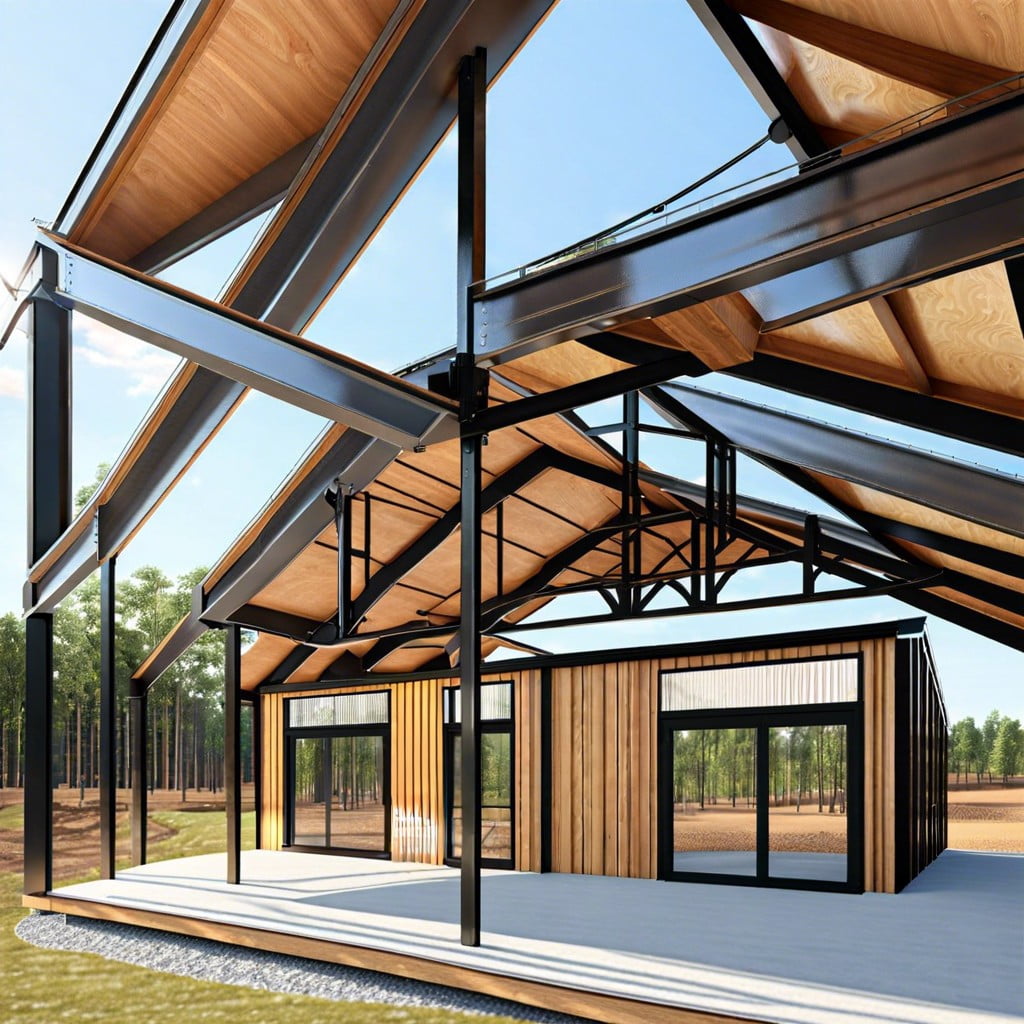This article compares the costs of steel buildings and wood frame construction, helping you decide which might be more cost-effective for your project.
Key takeaways:
- Steel has higher upfront costs, but narrowing price gap.
- Steel buildings have quicker assembly and lower labor costs.
- Steel is more durable and has longer lifespan compared to wood.
- Steel has higher initial environmental costs but can be offset by longevity.
- Steel structures have higher fire and seismic safety ratings.
Initial Material Costs for Steel Buildings Vs. Wood Buildings

Steel typically incurs higher upfront costs compared to wood due to its production and transportation processes. However, modern manufacturing advances have begun to narrow this price gap. The cost-effectiveness of wood, on the other hand, hinges largely on its widespread availability and ease of processing.
Local market fluctuations also play a crucial role; in regions with abundant timber resources, wood can be remarkably cost-effective. Conversely, in areas closer to steel manufacturing plants, the price of steel might be more competitive.
Understanding these divergences is essential for making an informed decision about construction materials based on regional economic landscapes and resource availability. Each choice affects the initial investment in the structure, with broader implications for overall project budgeting.
Construction Timeline and Labor Costs for Steel Vs. Wood
Steel buildings often benefit from quicker assembly due to prefabricated parts which fit together like a large-scale puzzle. This process reduces labor hours, cutting down on the cost of manpower. In contrast, wood construction typically involves more time. The need for extensive on-site craftsmanship to measure, cut, and fit lumber can extend the build time significantly.
Additionally, weather plays a less disruptive role in steel construction since most of the fabrication occurs indoors. Wood, susceptible to environmental factors, may incur delays and additional costs, especially in areas prone to inclement weather.
Though the initial hiring cost for specialized steel construction teams might be higher, the overall expense can be offset by the shorter construction period. Thus, when planning a project, consider both the direct costs and the potential for schedule overruns, which can affect overall budgeting and financial planning.
Longevity and Durability of Materials
Steel boasts impressive resilience against environmental stressors such as moisture, pests, and fire, substantially reducing the risk of degradation over time. In contrast, wood is susceptible to rot, termite damage, and fire, requiring more maintenance and potentially earlier replacement. The innate strength of steel also means it typically withstands severe weather conditions better than wood, which can warp or crack under extreme temperatures. Thus, steel structures often come with longer warranties, reflecting their extended lifespan compared to wood-framed buildings. This inherent durability makes steel a wise choice for those prioritizing longevity in their building investments.
Environmental Impact and Sustainability
Choosing between steel and wood involves considering their environmental footprints. Steel boasts high recyclability, meaning it can be reused without degradation in quality. In contrast, while wood is renewable, its sourcing, often involving deforestation, raises concerns about biodiversity and carbon storage.
Additionally, the energy consumption and emissions during production are higher for steel, but its longevity can offset these initial environmental costs. Wood, if not treated or sourced responsibly, might contribute to higher carbon emissions over its lifecycle due to issues such as rot or pest infestation necessitating replacements.
Using steel can also lead to lower waste on construction sites due to its prefabricated nature, which allows for precise manufacturing. Meanwhile, wood construction might result in more offcuts and waste, although these can sometimes be repurposed or recycled.
In evaluating sustainability, the choice also hinges on project-specific details like building purpose, location, and the likely frequency of maintenance or replacement.
Building Code and Safety Considerations
Steel structures often benefit from higher ratings in fire resistance and seismic safety. The non-combustible nature of steel reduces the fire load of a building, which can significantly influence compliance with local building codes. Additionally, steel’s ability to bend without breaking allows for greater flexibility during earthquakes, making steel-built structures more likely to remain intact.
On the other hand, wood frames, while generally offering decent seismic resilience, are more susceptible to fire damage. This vulnerability might necessitate additional investments in fire retardants or more comprehensive insurance coverage, which could affect overall costs and code compliance strategies.
Moreover, building codes frequently update their standards to improve safety and resilience. These updates might favor one material over the other based on the latest research and technology in disaster mitigation. Keeping abreast of these changes is crucial for planners and builders to make informed decisions that align with safety regulations and efficiency objectives.




